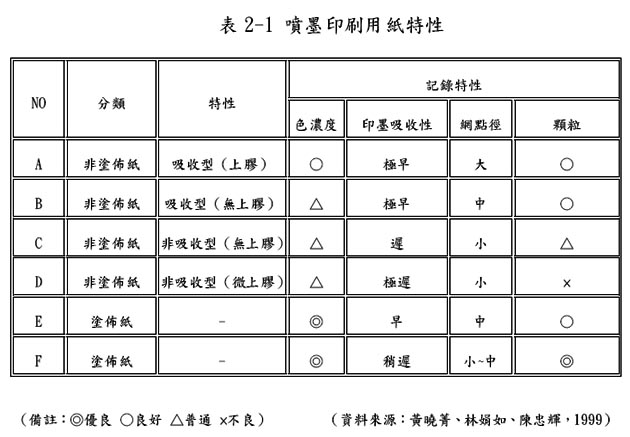Third, the classification of paper properties
Due to different pulping methods, fiber types, additive types, papermaking methods, and processing methods, papermaking will produce different types of papers. There will be different aspects in the application, and will also have different degrees of impact. The relationship between printing is more important than the printability of paper because it directly affects the quality of printing. (Zheng Maoti, 1998) From the perspective of printability:

(a) Printability
1. Appearance Properties: such as whiteness, paper color, gloss, opacity.
2. Chemical Composition and Related Properties (Chemical Composition and Related
Properties): such as paint composition, fiber-phase filler components, moisture content relative humidity, pH, white glue and water.
3.Structral Properties: Such as coated paper peel resistance, paper compressibility, dimensional stability, paper interweave and flat, wire direction, internal bond strength, air permeability, stiffness.
4. Surface Properties: such as the surface cleanliness, dirt, ink absorption, smoothness, surface strength, stripping resistance, both sides.
(b) From the point of view of inspection, the nature of paper can be divided into the following:
1. Physical Properties: such as basis weight, thickness, density, air permeability, smoothness, ink absorptivity, rule stability, curl.
2. Strength Properties: such as tensile strength, burst strength, tear resistance, flex resistance, and stiffness.
3. Optical Properties: such as whiteness, gloss, opacity, paper color.
4. Chemical Properties: Such as pH value, paper moisture content and relative humidity surface strength, sizing and water resistance.
5. Electrical Properties: Including electronic media strength, paper conductivity, paper insulation.
6. Microscopical Properties: such as fiber length, fiber structure. (Zheng Maoti, 1998)
(c) Paper Optical Properties: Whiteness
The optical properties of paper are determined by the amount of light it reaches onto the paper, which is determined by the state of incident light reflected, transmitted, scattered, and absorbed by the paper. The optical properties of the paper are affected by the optical properties of the material in the paper. Factors have the following factors
1. After the paper with a high degree of whiteness is printed in color, since the reflectance to light is high, the image has a high-order feeling and the printing effect is good.
2. The whiteness of Zhang itself directly affects the hue purity, brightness, and overprinting color of the printing ink layer.
3. High whiteness can increase printing contrast and make halftone dots perform better.
4. The book printing paper is not straight and is too high, because of the high reflectance, the reflected light will cause harm to the human eye.
5. The whiteness of the paper increases, and the printed gray scale decreases.
6. The whiteness of the paper increases, and the printing color effect improves.
7. The whiteness of the paper increases, and the difference in printing color decreases.
8. The whiteness of the paper increases, and the brightness value of the printing increases.
(d) Paper Optical Properties: Opacity
Opacity is the degree of blocking light penetration. Opacity is a very important feature of printing paper. Opacity is too low to easily cause a show thongh and low printing contrast.
The opacity factors of the image are:
1. Basic Weight – The basis weight of the paper increases and the opacity increases. The index of refraction between paper and air (Refeacitv Index) - The reflection and scattering of light into and through the paper is greatly affected by the refractive index of the medium. The greater the refractive index, the higher the opacity.
2. Refinement – ​​The longer the slurry is refined, the lower the opacity.
3. Fillers - Increased fillers increase the surface scattering coefficient of the paper, resulting in increased opacity.
4. Dyestuffs - Because the dye absorbs or scatters light of a certain wavelength in the colored light, the opacity increases.
5. Pulp and Bleaching – Different slurries or different bleaching methods can affect opacity.
6. The opacity of the paper is affected by the following factors: particle size, refraction rate, shape, distribution, medium amount of the pigment particles, diameter of the pigment particles acting on the phase surface, and the amount and size of the filler affect the heat dissipation coefficient and the opacity effect . (Zheng Maoti, 1998)
Dermal Fillers in your 20's
If you love the look of plumper, fuller lips, you may choose to have lip augmentation in your early twenties. If you feel your face is flatter and you want more structure, you may choose to undergo cheek augmentation. Many younger people undergo Filler Injections to enhance the chin or jawline.
Dermal fillers in your 30's and 40's
Men and women in their thirties and forties rely on filler injections to smooth away smile lines and marionette lines as they start to appear. The goal at this stage is to slow the process and prevent deeper lines and folds to maintain a more youthful appearance. Dermal fillers also offer a non-invasive solution that allows you to make subtle adjustments to chin, jawline, nose, or cheeks for rejuvenated look.
Dermal fillers in your 50's
Women and men in their fifties and older want to restore volume and reduce the appearance of wrinkles and lines often rely on regular Dermal Filler Injections. The loss of collagen can result in a sunken, aged look at the cheeks and temples. This makes the treatment a great option for anyone who wants a rejuvenated look without the commitment and downtime of an invasive surgical treatment.
Filler Injections Under Eyes,Under Eye Filler,Tear Trough Filler,Under Eye Fillers For Dark Circles
Rimless Industry Co.,Ltd. , https://www.rebornplla.com